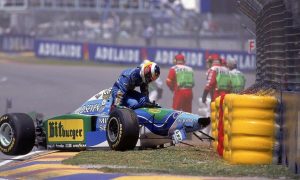NO MAJOR LAYOUT CHANGE PLANNED FOR 2016
Honda had originally planned on offsetting the small size of its turbocharger by a higher rotational speed (well above the usual 12,000rpm, according to Mark Hughes). The initial idea was to draw less air but more quickly in order to have the same power output.
But the Japanese manufacturer has never managed to pull this off without encountering any reliability and overheating issues. These woes would even be compounded by Honda’s MGU-H apparently sitting right next to the red-hot turbine. In an effort to improve reliability, Honda would thus be forced to lower the turbocharger’s rotational speed. This would in turn limit air compression, curb ICE power, and reduce the amount of energy that can be absorbed from the turbine.
The initial idea was to draw less air but more quickly in order to have the same power output.
In order to fix the issue, there are two main possible solutions. The first option is to keep the same power unit architecture and make the downsized turbocharger design work. That would entail finally reaching the required higher rotational speeds, something Honda has failed to accomplish so far…
Despite the current reality, Honda motorsport boss Yasuhisa Arai recently said that this ambitious endeavour remained his favoured choice for 2016.
“Looking at this year and next year, we’ve already gone in to a plan on how to make it better based on the current layout,” Arai told F1i, speaking via a translator. “The final plan may come in winter but we are already on it.
“It will be the base we work from because it’s the layout we’ve worked on from scratch with McLaren. We think there’s the possibility there, that’s why we fixed on that layout. So there is more potential to be had.”
The second possible option would be to increase the size of the turbocharger in order to boost engine power, although things are not that simple, nor automatic*. Plus it would go against McLaren chairman Ron Dennis’ “size zero” design philosophy.
In both cases, engineers at Sakura will have to thoroughly develop their power unit ahead of next year, which means spending many of their 32 tokens allocated for 2016. Will they be able to make Ferrari-like strides in one winter? Such a feat would probably require poaching top personnel away from its rivals, an option rejected by Honda, which could hire consultants instead, as suggested by Eric Boullier to F1i.
Looking at the bottom of the picture, one can spot the engine water and oil coolers, the MGU-K (which must be homologated by the FIA, hence the sticker) and, on the same shaft, what probably are the pressure and drain pumps for the crankcase.
*"There is not any real proportional correlation between the size of the compressor and the power of the MGU-H," Renault Sport F1 director of operations Remi Taffin told F1i. "Simplifying to the extreme, the level of boost pressure defines the size and workload of the compressor, which in turn will have an impact on the design of the turbine."








